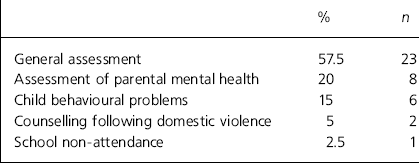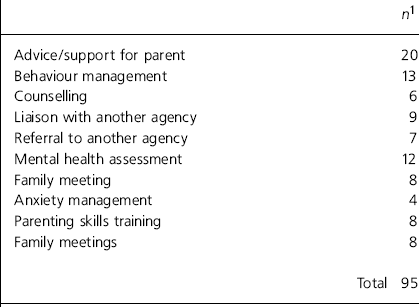At any one time, over 60 000 families in England are defined as homeless by local authorities. An initial research project including 114 homeless families (with 249 children) in Birmingham identified a high level of unmet mental health needs (Vostanis et al, Reference Vostanis, Grattan and Cumella1997, Reference Vostanis, Grattan and Cumella1998). Homeless mothers reported significantly higher rates of psychiatric morbidity (up to 50%) than a comparison group of mothers living in permanent housing. Homeless children were more likely to have histories of abuse, living in care, being on the at-risk protection register, delayed communication and higher reported mental health problems. Despite the high rates of psychiatric morbidity in children (estimated at 30%) and parents (estimated at 50%), only 3% of the children and less than 10% of the mothers had been seen by a mental health worker during the preceding year.
In contrast with single adult homeless people (Reference Commander, Odell and SashidharanCommander et al, 1997), there has been no systematic development of mental health services for this needy population of children and families, who cannot access mainstream services at the time of crisis. Several service initiatives have been reported, often through the voluntary sector.
The study
Establishment of the service
In addition to organisational difficulties, multi-agency research to evaluate the level of unmet need in similar populations often raises anxiety in the welfare sectors involved. To avoid such problems and to enable the findings of the epidemiological survey to be used in a constructive way that would lead to policy planning and service development, the findings were regularly discussed with and disseminated jointly to the local authority, particularly the Housing Department. At two milestones of the project (the completion of the cross-sectional and the longitudinal studies) conferences were organised with the participation of all sectors involved.
The first conference involved directors and senior managers (commissioners and policy-makers) to set the framework and directions of the service. The second invited the directors of education, social services, housing and health to report on the progress of each sector, but also involved ‘front-line’ staff from all agencies working with homeless families. Problems were identified in multi-agency workshops and summarised in a conference report. Funding for a designated community psychiatric nurse (CPN) post was made available at this stage.
The next step was the establishment of a multiagency group for the city. Its aims were to: identify homeless children and families with unmet needs within each sector; advocate for new resources; improve existing services (e.g. health visiting and schooling); and ensure the inclusion of homeless families in policy and commissioning documents (e.g. children's services plans). Participants included a general practitioner, a health visitor, a CPN for the homeless, a child psychiatrist, a consultant paediatrician, a representative of Women's Aid, and managers from housing, health, education and social services. Despite different priorities within each agency, it was essential to establish a group of this nature from the beginning, to prevent conflict between health and local authority agencies.
Service objectives
The service objectives took into account the characteristics of homeless families, i.e. repeated hostel admissions and moves, and the absence or uncoordinated provision of mental health, educational and social services. Pragmatic aims were identified:
-
(a) assessment and brief treatment of mental disorders in children and parents (e.g. depression, post-traumatic stress disorder);
-
(b) liaison with appropriate agencies (education, social services, child protection, local mental health services, voluntary and community organisations) to facilitate the re-integration of the family into the community, and particularly their engagement with local services following rehousing; and
-
(c) training of staff of homeless centres in the understanding, recognition and management of mental illness in children and parents. This is essential, as hostel staff often work in isolation and have little knowledge of the potential severity and consequences of mental health problems in children. It also has implications for other evolving community child mental health care models.
Function of the service
To maximise the impact of limited resources, regular outreach sessions are held at identified centres for homeless families. There is also, however, flexible response if necessary. To avoid screening all admissions, referral criteria have been established, either in relation to mental health concerns in parents and children (including learning disability), or through identification of high-risk families (e.g. those in which there are victims of domestic violence or established or suspected child protection issues). Because of the interface between different agencies, a weekly inter-agency meeting is held at each hostel, when all families are discussed. Certain agencies have been reluctant to be represented fearing an increase in their generic case-load. Intervention by agencies has therefore been ad hoc, their contribution often fragmented and hence not cost-effective.
Direct work with children and families is faced with constraints, because of the brief length of stay and the complexity of psychosocial problems. Mental health care and housing staff are often seen as the only route to a number of services, and workers are faced with a range of social work requests. The need for a designated social worker, keyworker or even advocate is apparent. Despite the limited period of involvement, direct work and treatment can be effective. Time-limited behavioural therapy or advice is given to parents and staff on how to deal with children's aggressive behaviour, bedwetting or sleep problems. Brief supportive psychotherapy is offered to children who have experienced major trauma. Children with learning disabilities and special educational needs are over-represented in this population and in urgent need of special school provision. Parents (usually mothers) often have histories of recurrent depressive or anxiety episodes, substance misuse, personality disorders and erratic contact with adult mental health services.
Referrals
During the first 12 months, 40 families with 122 children were referred to the team. Most (72.5%, n=29) were single mothers with children. Of the parents referred, 82.5% (33) were White, 12.5% (5) Asian and 5% (2) African-Caribbean. Of the children 62.5% (25) were White, 22.5% (9) were mixed race, 10% (4) Asian and 5% (2) African-Caribbean. Reasons for homelessness are summarised in Table 1. All families were referred via a weekly inter-agency meeting at homeless centres. For reasons for referral see Table 2. Most families referred to the team (55%) were seen on average for 1-3 sessions, and a further 22.5% were seen 4-6 times. Treatment and interventions are summarised in Table 3.
Table 1. Reasons for homelessness (n=40 families)

| % | n | |
|---|---|---|
| Domestic violence | 47.5 | 19 |
| Harassment by neighbour | 32.5 | 13 |
| Eviction | 7.5 | 3 |
| Overcrowding | 5.0 | 2 |
| Family violence | 2.5 | 1 |
| Natural disaster | 2.5 | 1 |
| Released from prison | 2.5 | 1 |
Table 2. Reasons for referral (n=40 families)

| % | n | |
|---|---|---|
| General assessment | 57.5 | 23 |
| Assessment of parental mental health | 20 | 8 |
| Child behavioural problems | 15 | 6 |
| Counselling following domestic violence | 5 | 2 |
| School non-attendance | 2.5 | 1 |
Table 3. Treatment and intervention (n=40 families)

| n 1 | |
|---|---|
| Advice/support for parent | 20 |
| Behaviour management | 13 |
| Counselling | 6 |
| Liaison with another agency | 9 |
| Referral to another agency | 7 |
| Mental health assessment | 12 |
| Family meeting | 8 |
| Anxiety management | 4 |
| Parenting skills training | 8 |
| Family meetings | 8 |
| Total 95 |
Discussion
These findings reflect some of the complexities of working with the homeless population. The nature and range of interventions offered demonstrates the multiple needs, such as social, educational and mental health problems, of many homeless families. The findings also indicate some of the difficulties in separating child and parental mental health needs. Despite efforts to focus on the mental health needs of the children, many mothers were preoccupied with their own needs. Around 25% of cases did not attend for appointments. This was frustrating, but not surprising given that the mental health needs of these families are often not their first priority: many state that their primary needs are rehousing and financial stability. In addition, many families perceived that physical health deserved higher priority than mental health. The reason for this is unclear and may require further investigation.
Regular contact with the families is crucial. Some may cope well when they initially become homeless and may feel relieved to have escaped from an unhappy or violent home situation. A prolonged stay in a hostel, however, may provoke the onset of depression in parents or behavioural problems in children. It is therefore important to revisit families who have been homeless for a longer period. Referrals should be discussed in regular team meetings, as hostel staff may be more likely to refer families whose parents can articulate their needs, or whose children have clear behavioural problems. Those families who are quieter or more withdrawn, but who may be no less in need of a service, could then be overlooked.
The needs of homeless families require a multi-disciplinary response, and the team has set up a monthly steering group in an endeavour to engage and coordinate other agencies (such as social services, primary care and the voluntary sector) in order to increase the range of services available. This has been problematic, as some services, for example social services, have resource constraints. Although other agencies acknowledge the significant needs of the homeless population, their direct involvement can often be attributed to the goodwill of a number of committed professionals. A rolling programme of training is offered to housing staff to increase awareness of mental health issues and ensure appropriate referrals to the team. In addition, a quarterly newsletter is produced to try to raise awareness of the problems that homeless families face. It is also important to note that designated time to work with this population has been secured in order to support staff in the team who have an additional generic case-load and therefore competing pressures to deal with.
This service model is currently being evaluated by a research team funded by the NHS Research and Development programme. The service is constantly evolving, often because of changes in the housing legislation and the homeless population. In the past year, there has been a substantial increase in the refugee population outside London. Also, victimising families, rather than victims, are increasingly being moved to homeless centres, as a result of more protective legislation. It is hoped that similar models for socially excluded children and their families will emerge and be developed through local and health authority partnership.
Acknowledgements
We thank Cynthia Bower from the Birmingham Health Authority for her support in establishing this service. Also, the Birmingham Housing Department, particularly Daphne Agnew, and the centre managers for their help over the years. The current research evaluation of this service model is funded by a West Midlands NHS Executive Research and Development grant.






eLetters
No eLetters have been published for this article.